Lilium
| Lilium | |
|---|---|

| |
| Lilium candidum | |
| Scientific classification | |
| Kingdom: | Plantae |
| Clade: | Angiosperms |
| Clade: | Monocots |
| Order: | Liliales |
| Family: | Liliaceae |
| Subfamily: | Lilioideae |
| Tribe: | Lilieae |
| Genus: | Lilium L. |
| Type species | |
| Lilium candidum | |
| Species | |
| Synonyms[2] | |
Lilium (members of which are true lilies) is a genus of herbaceous flowering plants growing from bulbs, all with large prominent flowers. Lilies are a group of flowering plants which are important in culture and literature in much of the world. Most species are native to the temperate northern hemisphere, though their range extends into the northern subtropics. Many other plants have "lily" in their common name but are not related to true lilies.
Description
Lilies are tall perennials ranging in height from 2–6 ft (60–180 cm). They form naked or tunicless scaly underground bulbs which are their organs of perennation. In some North American species the base of the bulb develops into rhizomes, on which numerous small bulbs are found. Some species develop stolons. Most bulbs are buried deep in the ground, but a few species form bulbs near the soil surface. Many species form stem-roots. With these, the bulb grows naturally at some depth in the soil, and each year the new stem puts out adventitious roots above the bulb as it emerges from the soil. These roots are in addition to the basal roots that develop at the base of the bulb.
The flowers are large, often fragrant, and come in a wide range of colors including whites, yellows, oranges, pinks, reds and purples. Markings include spots and brush strokes. The plants are late spring- or summer-flowering. Flowers are borne in racemes or umbels at the tip of the stem, with six tepals spreading or reflexed, to give flowers varying from funnel shape to a "Turk's cap". The tepals are free from each other, and bear a nectary at the base of each flower. The ovary is 'superior', borne above the point of attachment of the anthers. The fruit is a three-celled capsule.[3]
Seeds ripen in late summer. They exhibit varying and sometimes complex germination patterns, many adapted to cool temperate climates.
Naturally most cool temperate species are deciduous and dormant in winter in their native environment. But a few species which distribute in hot summer and mild winter area (Lilium candidum, Lilium catesbaei, Lilium longiflorum) lose leaves and remain relatively short dormant in Summer or Autumn, sprout from Autumn to winter, forming dwarf stem bearing a basal rosette of leaves until, after they have received sufficient chilling, the stem begins to elongate in warming weather.
The basic chromosome number is twelve (n=12).[4]
Taxonomy
Taxonomical division in sections follows the classical division of Comber,[5] species acceptance follows the World Checklist of Selected Plant Families,[6] the taxonomy of section Pseudolirium is from the Flora of North America,[7] the taxonomy of Section Liriotypus is given in consideration of Resetnik et al. 2007,[8] the taxonomy of Chinese species (various sections) follows the Flora of China[9] and the taxonomy of Section Sinomartagon follows Nishikawa et al.[10] as does the taxonomy of Section Archelirion.[11]
The World Checklist of Selected Plant Families, as of January 2014[update], considers Nomocharis a separate genus in its own right,[12] however some authorities consider Nomocharis to be embedded within Lilium, rather than treat it as a separate genus.[13][14]
There are seven sections:
- Martagon
- Pseudolirium
- Liriotypus
- Archelirion
- Sinomartagon
- Leucolirion
- Daurolirion
For a full list of accepted species[2] with their native ranges, see List of Lilium species
| Picture | Section | Sub Section | Botanical name | common name |
|---|---|---|---|---|
 |
Martagon | Lilium distichum | ||
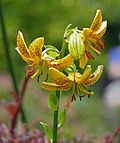 |
Martagon | Lilium hansonii | ||
 |
Martagon | Lilium martagon | Martagon or Turk's cap lily | |
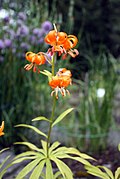 |
Martagon | Lilium medeoloides | ||
 |
Martagon | Lilium tsingtauense | ||
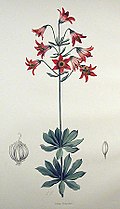 |
Pseudolirium | 2a | Lilium bolanderi | Bolander's Lily |
 |
Pseudolirium | 2a | Lilium puberulum | |
 |
Pseudolirium | 2a | Lilium kelloggii | |
 |
Pseudolirium | 2a | Lilium rubescens | |
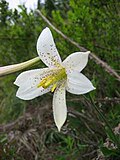 |
Pseudolirium | 2a | Lilium washingtonianum | Washington Lily, Shasta Lily, or Mt. Hood Lily |
 |
Pseudolirium | 2b | Lilium kelleyanum | |
 |
Pseudolirium | 2b | Lilium maritimum | |
 |
Pseudolirium | 2b | Lilium occidentale | |
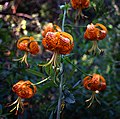 |
Pseudolirium | 2b | Lilium pardalinum | Panther or Leopard lily |
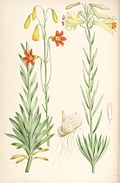 |
Pseudolirium | 2b | Lilium parryi | |
 |
Pseudolirium | 2b | Lilium parvum | Sierra tiger lily or Alpine lily |
 |
Pseudolirium | 2c | Lilium canadense | Canada Lily or Meadow Lily |
 |
Pseudolirium | 2c | Lilium grayi | |
 |
Pseudolirium | 2c | Lilium iridollae | |
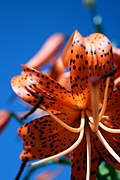 |
Pseudolirium | 2c | Lilium michiganense | Michigan Lily |
 |
Pseudolirium | 2c | Lilium michauxii | Carolina Lily |
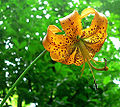 |
Pseudolirium | 2c | Lilium superbum | Swamp lily or American tiger lily |
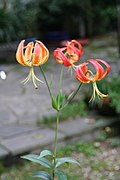 |
Pseudolirium | 2c | Lilium pyrophilum | Sandhills Lily[15] |
 |
Pseudolirium | 2d | Lilium catesbaei | |
 |
Pseudolirium | 2d | Lilium philadelphicum | Wood lily, Philadelphia lily or prairie lily |
 |
Liriotypus | 3a | Lilium candidum | Madonna lily |
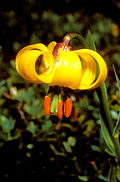 |
Liriotypus | 3b | Lilium albanicum | |
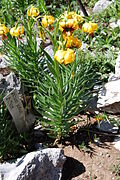 |
Liriotypus | 3b | Lilium bosniacum (Lilium carniolicum var. bosniacum) | |
 |
Liriotypus | 3b | Lilium chalcedonicum | |
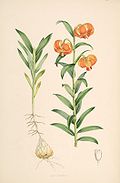 |
Liriotypus | 3b | Lilium carniolicum | |
 |
Liriotypus | 3b | Lilium ciliatum | |
| Liriotypus | 3b | Lilium heldreichii | ||
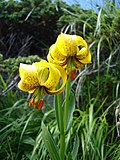 |
Liriotypus | 3b | Lilium jankae | |
 |
Liriotypus | 3b | Lilium pomponium | Turban lily |
 |
Liriotypus | 3b | Lilium ponticum | |
 |
Liriotypus | 3b | Lilium pyrenaicum | |
 |
Liriotypus | 3c | Lilium akkusianum | |
 |
Liriotypus | 3c | Lilium kesselringianum | |
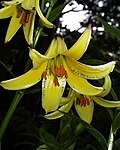 |
Liriotypus | 3c | Lilium monadelphum | |
 |
Liriotypus | 3c | Lilium rhodopeum | |
 |
Liriotypus | 3c | Lilium szovitsianum | Polish Lily |
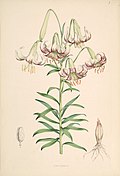 |
Liriotypus | 3c | Lilium polyphyllum | |
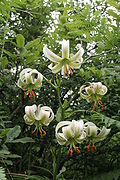 |
Liriotypus | 3c | Lilium ledebourii | |
 |
Liriotypus | 3d | Lilium bulbiferum | Orange Lily or Fire Lily |
 |
Archelirion | 4a | Lilium speciosum | Japanese lily |
 |
Archelirion | 4b | Lilium auratum | Golden rayed lily of Japan, or Goldband lily |
 |
Archelirion | 4c | Lilium alexandrae | |
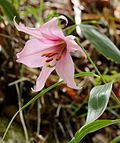 |
Archelirion | 4c | Lilium japonicum | |
 |
Archelirion | 4c | Lilium nobilissimum | |
 |
Archelirion | 4d | Lilium brownii | |
 |
Archelirion | 4d | Lilium rubellum | |
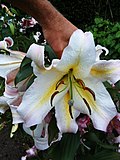 |
Archelirion | 4d | Lilium platyphyllum | |
 |
Sinomartagon | 5a | Lilium davidii | |
 |
Sinomartagon | 5a | Lilium duchartrei | |
 |
Sinomartagon | 5a | Lilium henryi | Tiger Lily or Henry's lily |
 |
Sinomartagon | 5a | Lilium lancifolium | Tiger Lily (often known as L. tigrinum) |
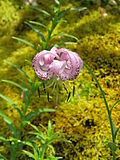 |
Sinomartagon | 5a | Lilium lankongense | |
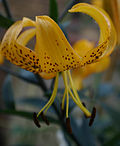 |
Sinomartagon | 5a | Lilium leichtlinii | |
 |
Sinomartagon | 5a | Lilium papilliferum | |
 |
Sinomartagon | 5a | Lilium rosthornii | |
 |
Sinomartagon | 5b | Lilium amabile | |
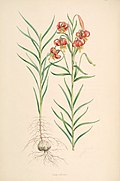 |
Sinomartagon | 5b | Lilium callosum | |
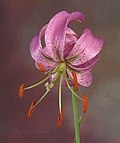 |
Sinomartagon | 5b | Lilium cernuum | |
 |
Sinomartagon | 5b | Lilium concolor | Morning Star Lily |
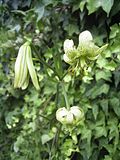 |
Sinomartagon | 5b | Lilium fargesii | |
 |
Sinomartagon | 5b | Lilium pumilum | Coral Lily, Low Lily, or Siberian Lily |
| Sinomartagon | 5b | Lilium xanthellum | ||
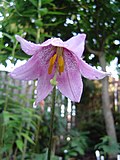 |
Sinomartagon | 5c | Lilium amoenum | |
| Sinomartagon | 5c | Lilium arboricola | ||
 |
Sinomartagon | 5c | Lilium bakerianum | |
 |
Sinomartagon | 5c | Lilium euxanthum | |
| Sinomartagon | 5c | Lilium henrici | ||
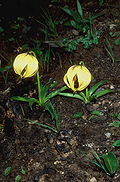 |
Sinomartagon | 5c | Lilium lophophorum | |
 |
Sinomartagon | 5c | Lilium mackliniae | Siroi Lily |
 |
Sinomartagon | 5c | Lilium majoense | |
 |
Sinomartagon | 5c | Lilium nanum | |
 |
Sinomartagon | 5c | Lilium nepalense | |
 |
Sinomartagon | 5c | Lilium oxypetalum | |
| Sinomartagon | 5c | Lilium paradoxum | ||
 |
Sinomartagon | 5c | Lilium poilanei | |
 |
Sinomartagon | 5c | Lilium primulinum | |
| Sinomartagon | 5c | Lilium sempervivoideum | ||
| Sinomartagon | 5c | Lilium sherriffiae | ||
 |
Sinomartagon | 5c | Lilium souliei | |
| Sinomartagon | 5c | Lilium stewartianum | ||
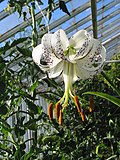 |
Sinomartagon | 5c | Lilium taliense | |
 |
Sinomartagon | 5c | Lilium wardii | |
| Sinomartagon | 5? | Lilium brevistylum | ||
 |
Sinomartagon | 5? | Lilium lijiangense | |
| Sinomartagon | 5? | Lilium anhuiense | ||
| Sinomartagon | 5? | Lilium eupetes | ||
 |
Sinomartagon | 5? | Lilium habaense | |
| Sinomartagon | 5? | Lilium huidongense | ||
| Sinomartagon | 5? | Lilium jinfushanense | ||
| Sinomartagon | 5? | Lilium matangense | ||
| Sinomartagon | 5? | Lilium medogense | ||
| Sinomartagon | 5? | Lilium pinifolium | ||
| Sinomartagon | 5? | Lilium pyi | ||
| Sinomartagon | 5? | Lilium saccatum | ||
| Sinomartagon | 5? | Lilium tianschanicum | ||
| Sinomartagon | 5? | Lilium floridum | ||
 |
Leucolirion | 6a | Lilium leucanthum | |
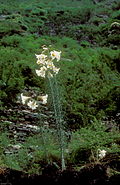 |
Leucolirion | 6a | Lilium regale | |
 |
Leucolirion | 6a | Lilium sargentiae | |
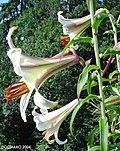 |
Leucolirion | 6a | Lilium sulphureum | |
 |
Leucolirion | 6a | Lilium wenshanense | |
| Leucolirion | 6b | Lilium anhuiense | ||
 |
Leucolirion | 6b | Lilium formosanum | |
 |
Leucolirion | 6b | Lilium longiflorum | Easter Lily |
| Leucolirion | 6b | Lilium neilgherrense | ||
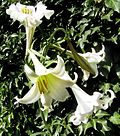 |
Leucolirion | 6b | Lilium philippinense | Benguet lily[16][17] |
 |
Leucolirion | 6b | Lilium wallichianum | |
| Leucolirion | 6b | Lilium zairii | ||
 |
Leucolirion | 6b | Lilium puerense | |
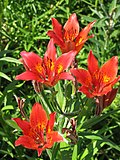 |
Daurolirion | Lilium dauricum | ||
 |
Daurolirion | Lilium maculatum | ||
 |
Daurolirion | Lilium pensylvanicum | ||
| Lilium eupetes | ||||
 |
Lilium armenum | |||
 |
Lilium bosniacum | |||
 |
Lilium columbianum | |||
 |
Lilium debile | |||
 |
Lilium humboldtii | |||
| Lilium rockii |
Some species formerly included within this genus have now been placed in other genera. These genera include Cardiocrinum, Notholirion, Nomocharis and Fritillaria.
Etymology
The botanic name Lilium is the Latin form and is a Linnaean name. The Latin name is derived from the Greek λείριον, leírion, generally assumed to refer to true, white lilies as exemplified by the Madonna lily.[18][19] The word was borrowed from Coptic (dial. Fayyumic) hleri, from standard hreri, from Demotic hrry, from Egyptian hrṛt "flower".[citation needed] Meillet maintains that both the Egyptian and the Greek word are possible loans from an extinct, substratum language of the Eastern Mediterranean.[citation needed] The Greeks also used the word κρῖνον, krīnon, albeit for non-white lilies.[citation needed]
The term "lily" has in the past been applied to numerous flowering plants, often with only superficial resemblance to the true lily, including water lily, fire lily, lily of the Nile, calla lily, trout lily, kaffir lily, cobra lily, lily of the valley, daylily, ginger lily, Amazon lily, leek lily, Peruvian lily, and others. All English translations of the Bible render the Hebrew shūshan, shōshan, shōshannā as "lily", but the "lily among the thorns" of Song of Solomon, for instance, may be the honeysuckle.[20]
For a list of other species described as lilies, see Lily (disambiguation).
Distribution and habitat
The range of lilies in the Old World extends across much of Europe, across most of Asia to Japan, south to India, and east to Indochina and the Philippines. In the New World they extend from southern Canada through much of the United States. They are commonly adapted to either woodland habitats, often montane, or sometimes to grassland habitats. A few can survive in marshland and epiphytes are known in tropical southeast Asia. In general they prefer moderately acidic or lime-free soils.
Ecology
Lilies are used as food plants by the larvae of some Lepidoptera species including the Dun-bar.
Cultivation
Many species are widely grown in the garden in temperate and sub-tropical regions. They may also be grown as potted plants. Numerous ornamental hybrids have been developed. They can be used in herbaceous borders, woodland and shrub plantings, and as patio plants. Some lilies, especially Lilium longiflorum, form important cut flower crops. These may be forced for particular markets; for instance, Lilium longiflorum for the Easter trade, when it may be called the Easter lily.
Lilies are usually planted as bulbs in the dormant season. They are best planted in a south-facing (northern hemisphere), slightly sloping aspect, in sun or part shade, at a depth 2½ times the height of the bulb (except Lilium candidum which should be planted at the surface). Most prefer a porous, loamy soil, and good drainage is essential. Most species bloom in July or August (northern hemisphere). The flowering periods of certain lily species begin in late spring, while others bloom in late summer or early autumn.[21] They have contractile roots which pull the plant down to the correct depth, therefore it is better to plant them too shallowly than too deep. A soil pH of around 6.5 is generally safe. The soil should be well-drained, and plants must be kept watered during the growing season. Some plants have strong wiry stems, but those with heavy flower heads may need staking.[22][23]
Awards
The following lily species and cultivars currently hold the Royal Horticultural Society's Award of Garden Merit (confirmed 2017):[24]
- African Queen Group (VI-/a) 2002 H6
- 'Casa Blanca' (VIIb/b-c) 1993 H6
- 'Fata Morgana' (Ia/b) 2002 H6
- 'Garden Party' (VIIb/b) 2002 H6
- Golden Splendor Group (VIb-c/a)[25]
- Lilium henryi (IXc/d) 1993 H6
- Lilium mackliniae (IXc/a) 2012 H5
- Lilium martagon – Turk’s cap lily (IXc/d)[26]
- Lilium pardalinum – leopard lily (IXc/d)[27]
- Pink Perfection Group (VIb/a)[28]
- Lilium regale – regal lily, king’s lily (IXb/a)[29]
Classification of garden forms
Numerous forms, mostly hybrids, are grown for the garden. They vary according to the species and interspecific hybrids that they derived from, and are classified in the following broad groups:[30][31][32]
Asiatic hybrids (Division I)
- These are derived from hybrids between species in Lilium section Sinomartagon.[33][34]
- They are derived from central and East Asian species and interspecific hybrids, including Lilium amabile, Lilium bulbiferum, Lilium callosum, Lilium cernuum, Lilium concolor, Lilium dauricum, Lilium davidii, Lilium × hollandicum, Lilium lancifolium (syn. Lilium tigrinum), Lilium lankongense, Lilium leichtlinii, Lilium × maculatum, Lilium pumilum, Lilium × scottiae, Lilium wardii and Lilium wilsonii.
- These are plants with medium-sized, upright or outward facing flowers, mostly unscented. There are various cultivars such as Lilium 'Cappuccino', Lilium 'Dimension', Lilium 'Little Kiss' and Lilium 'Navona'.[35]
- Dwarf (Patio, Border) varieties are much shorter, c.36–61 cm in height and were designed for containers.[36] They often bear the cultivar name 'Tiny', such as the 'Lily Looks' series, e.g. 'Tiny Padhye',[37] 'Tiny Dessert'.[38]
Martagon hybrids (Division II)
- These are based on Lilium dalhansonii, Lilium hansonii, Lilium martagon, Lilium medeoloides, and Lilium tsingtauense.
- The flowers are nodding, Turk's cap style (with the petals strongly recurved).
Candidum (Euro-Caucasian) hybrids (Division III)
- This includes mostly European species: Lilium candidum, Lilium chalcedonicum, Lilium kesselringianum, Lilium monadelphum, Lilium pomponium, Lilium pyrenaicum and Lilium × testaceum.
American hybrids (Division IV)
- These are mostly taller growing forms, originally derived from Lilium bolanderi, Lilium × burbankii, Lilium canadense, Lilium columbianum, Lilium grayi, Lilium humboldtii, Lilium kelleyanum, Lilium kelloggii, Lilium maritimum, Lilium michauxii, Lilium michiganense, Lilium occidentale, Lilium × pardaboldtii, Lilium pardalinum, Lilium parryi, Lilium parvum, Lilium philadelphicum, Lilium pitkinense, Lilium superbum, Lilium ollmeri, Lilium washingtonianum, and Lilium wigginsii.
- Many are clump-forming perennials with rhizomatous rootstocks.
Longiflorum hybrids (Division V)
- These are cultivated forms of this species and its subspecies.
- They are most important as plants for cut flowers, and are less often grown in the garden than other hybrids.
Trumpet lilies (Division VI), including Aurelian hybrids (with L. henryi)
- This group includes hybrids of many Asiatic species and their interspecific hybrids, including Lilium × aurelianense, Lilium brownii, Lilium × centigale, Lilium henryi, Lilium × imperiale, Lilium × kewense, Lilium leucanthum, Lilium regale, Lilium rosthornii, Lilium sargentiae, Lilium sulphureum and Lilium × sulphurgale.
- The flowers are trumpet shaped, facing outward or somewhat downward, and tend to be strongly fragrant, often especially night-fragrant.
Oriental hybrids (Division VII)
- These are based on hybrids within Lilium section Archelirion,[33][34] specifically Lilium auratum and Lilium speciosum, together with crossbreeds from several species native to Japan, including Lilium nobilissimum, Lilium rubellum, Lilium alexandrae, and Lilium japonicum.
- They are fragrant, and the flowers tend to be outward facing. Plants tend to be tall, and the flowers may be quite large. The whole group are sometimes referred to as "stargazers" because many of them appear to look upwards. (For the specific cultivar, see Lilium 'Stargazer'.)
Other hybrids (Division VIII)
- Includes all other garden hybrids.
Species (Division IX)
- All natural species and naturally occurring forms are included in this group.
The flowers can be classified by flower aspect and form:[39]
- Flower aspect:
- a up-facing
- b out-facing
- c down-facing
- Flower form:
- a trumpet-shaped
- b bowl-shaped
- c flat (or with tepal tips recurved)
- d tepals strongly recurved (with the Turk's cap form as the ultimate state)
Many newer commercial varieties are developed by using new technologies such as ovary culture and embryo rescue.[40]
Pests and diseases

Aphids may infest plants. Leatherjackets feed on the roots. Larvae of the Scarlet lily beetle can cause serious damage to the stems and leaves. The scarlet beetle lays its eggs and completes its life cycle only on true lilies (Lilium) and fritillaries (Fritillaria).[41] Oriental, rubrum, tiger and trumpet lilies as well as Oriental trumpets (orienpets) and Turk's cap lilies and native North American Lilium species are all vulnerable, but the beetle prefers some types over others. The beetle could also be having an effect on native Canadian species and some rare and endangered species found in northeastern North America.[42] Daylilies (Hemerocallis, not true lilies) are excluded from this category. Plants can suffer from damage caused by mice, deer and squirrels. Slugs, snails and millipedes attack seedlings, leaves and flowers. Brown spots on damp leaves may signal botrytis (also known as lily disease). Various fungal and viral diseases can cause mottling of leaves and stunting of growth.
Propagation and growth
Lilies can be propagated in several ways;
- by division of the bulbs
- by growing-on bulbils which are adventitious bulbs formed on the stem
- by scaling, for which whole scales are detached from the bulb and planted to form a new bulb
- by seed; there are many seed germination patterns, which can be complex
- by micropropagation techniques (which include tissue culture);[43] commercial quantities of lilies are often propagated in vitro and then planted out to grow into plants large enough to sell.
According to a study done by Anna Pobudkiewicz and Jadwiga the use of flurprimidol foliar spray helps aid in the limitation of stem elongation in oriental lilies. (1)
Toxicity
<section begin=lilium-toxicity />Some Lilium species are toxic to cats. This is known to be so especially for Lilium longiflorum though other Lilium and the unrelated Hemerocallis can also cause the same symptoms.[44][45][46][47] The true mechanism of toxicity is undetermined, but it involves damage to the renal tubular epithelium (composing the substance of the kidney and secreting, collecting, and conducting urine), which can cause acute renal failure.[47] Veterinary help should be sought, as a matter of urgency, for any cat that is suspected of eating any part of a lily – including licking pollen that may have brushed onto its coat.[48]<section end=lilium-toxicity />
Culinary and herb uses
China
Lilium bulbs are starchy and edible as root vegetables, although bulbs of some species may be very bitter. The non-bitter bulbs of Lilium lancifolium, Lilium pumilum, and especially Lilium brownii (Chinese: 百合; pinyin: bǎihé) and Lilium davidii var. unicolor are grown on a large scale in China as a luxury or health food, and are most often sold in dry form for herb, the fresh form often appears with other vegetables. The dried bulbs are commonly used in the south to flavor soup. Lily flowers are also said to be efficacious in pulmonary affections, and to have tonic properties.[49] Lily flowers and bulbs are eaten especially in the summer, for their perceived ability to reduce internal heat.[50] They may be reconstituted and stir-fried, grated and used to thicken soup, or processed to extract starch. Their texture and taste draw comparisons with the potato, although the individual bulb scales are much smaller. There are also species which are meant to be suitable for culinary and/or herb uses. There are five traditional lily species whose bulbs are certified and classified as "vegetable and non-staple foodstuffs" on the National geographical indication product list of China.[51]
- Culinary use:[52]
- 野百合Lilium brownii, 百合 Lilium brownii var. viridulum, 渥丹 Lilium concolor, 毛百合 Lilium dauricum, 川百合 Lilium davidii, 东北百合 Lilium distichum, 卷丹 Lilium lancifolium, 新疆百合 Lilium martagon var. pilosiusculum, 山丹 Lilium pumilum, 南川百合Lilium rosthornii, 药百合Lilium speciosum var. gloriosoides.
- 野百合 Lilium brownii, 百合 Lilium brownii var. viridulum, 渥丹 Lilium concolor, 毛百合 Lilium dauricum, 卷丹 Lilium lancifolium, 山丹 Lilium pumilum, 南川百合 Lilium rosthornii, 药百合Lilium speciosum var. gloriosoides, 淡黄花百合 Lilium sulphureum.
- And there are researches about the selection of new varieties of edible lilies from the horticultural cultivars, such as 'Batistero' and 'California' among 15 lilies in Beijing,[55] and 'Prato' and 'Small foreigners' among 13 lilies in Ningbo.[56]
Japan
- Culinary use:
- Yuri-ne (lily-root) is also common in Japanese cuisine, especially as an ingredient of chawan-mushi (savoury egg custard). The major lilium species cultivated as vegetable are Lilium leichtlinii var. maximowiczii, Lilium lancifolium, and Lilium auratum.[57][58]
- Herb use:
North America
The flower buds and roots of Lilium canadense are traditionally gathered and eaten by North American indigenous peoples.[60] Coast Salish, Nuu-chah-nulth and most western Washington peoples steam, boil or pit-cook the bulbs of Lilium columbianum. Bitter or peppery-tasting, they were mostly used as a flavoring, often in soup with meat or fish.[61]
Taiwan
- Culinary use:
- The parts of lilium species which are officially listed as food material are the flower and bulbs of Lilium lancifolium Thunb., Lilium brownii var. viridulum Baker, Lilium pumilum DC., Lilium candidum Loureiro.[62] Most edible lily bulbs which can be purchased in a market are mostly imported from mainland China (only in the scale form, and most marked as 蘭州百合 Lilium davidii var. unicolor) and Japan (whole bulbs, should mostly be Lilium leichtlinii var. maximowiczii). There are already commercially available organic growing and normal growing edible lily bulbs. The varieties are selected by the Taiwanese Department of Agriculture from the Asiatic lily cultivars that are imported from the Netherlands; the seedling bulbs must be imported from the Netherlands every year.[63][64][65]
- Herb use:
- Lilium lancifolium Thunb., Lilium brownii var. viridulum Baker, Lilium pumilum DC.[66]
South Korea
- Herb use:
- The lilium species which are officially listed as herbs are 참나리 Lilium lancifolium Thunberg; 당나리 Lilium brownii var. viridulun Baker;[67][68]
Not Lilium
The "lily" flower buds known as jīnzhēn (金针, "golden needles") in Chinese cuisine are actually from Hemerocallis citrina.[69]
In culture
Symbolism
In the Victorian language of flowers, lilies portray love, ardor, and affection for your loved ones, while orange lilies stand for happiness, love, and warmth.[70]
Lilies are the flowers most commonly used at funerals, where they symbolically signify that the soul of the deceased has been restored to the state of innocence.[71]
Lilium formosanum, or Taiwanese lily, is called "the flower of broken bowl" (打碗花) by the elderly members of the Hakka ethnic group. They believe that because this lily grows near bodies of clean water, harming the lily may damage the environment, just like breaking the bowls that people rely on.[72] An alternative explanation is that parents convince children into not taking the lily by convincing the children that their dinner bowls may break if they destroy this flower.
Lilium longiflorum, the Easter lily, is a symbol of Easter, and Lilium candidum, the Madonna lily, carries a great deal of symbolic value in many cultures. See the articles for more information.
Heraldry
Lilium bulbiferum has long been recognised as a symbol of the Orange Order in Northern Ireland.[73]
Lilium mackliniae is the state flower of Manipur. Lilium michauxii, the Carolina lily, is the official state flower of North Carolina. Idyllwild, California, hosts the Lemon Lily Festival, which celebrates Lilium parryi.[74] Lilium philadelphicum is the floral emblem of Saskatchewan province in Canada, and is on the flag of Saskatchewan.[75][76][77]
Other plants referred to as lilies
Lily of the valley, flame lilies, and water lilies are symbolically important flowers commonly referred to as lilies, but they are not in the genus Lilium.
Gallery
Lilium regale : bud formation
Orange lily showing stamens with pollen-covered anthers, Ontario, Canada
Pollen of Lilium auratum (oriental lily); back-scattered electron microscope image
Microscopic view of lily pollen 100X
See also
References
- ↑ lectotype designated by N. L. Britton et A. Brown, Ill. Fl. N. U.S. ed. 2. 1: 502 (1913)
- ↑ Jump up to: 2.0 2.1 "Lilium". World Checklist of Selected Plant Families. Retrieved June 13, 2014.
- ↑ European Garden Flora; Volume 1
- ↑ Pelkonen, Veli-Pekka; Pirttilä, Anna-Maria (2012). "Taxonomy and Phylogeny of the Genus Lilium" (PDF). Floriculture and Ornamental Biotechnology. 6 (Special Issue 2): 1–8. Retrieved 2016-07-29.
- ↑ Harold Comber, 1949. "A new classification of the genus Lilium". Lily Yearbook, Royal Hortic. Soc., London. 15:86–105.
- ↑ Govaerts, R. (ed.). "Lilium". World Checklist of Selected Plant Families. The Board of Trustees of the Royal Botanic Gardens, Kew. Retrieved 2013-02-03.
- ↑ Flora of North America, Vol. 26, Online
- ↑ Resetnik I.; Liber Z.; Satovic Z.; Cigic P.; Nikolic T. (2007). "Molecular phylogeny and systematics of the Lilium carniolicum group (Liliaceae) based on nuclear ITS sequences". Plant Systematics and Evolution. 265: 45–58. doi:10.1007/s00606-006-0513-y.
- ↑ Flora of China, Vol. 24, eFloras.org
- ↑ Nishikawa Tomotaro; Okazaki Keiichi; Arakawa Katsuro; Nagamine Tsukasa (2001). "Phylogenetic Analysis of Section Sinomartagon in Genus Lilium Using Sequences of the Internal Transcribed Spacer Region in Nuclear Ribosomal DNA". 育種学雑誌 Breeding science. 51 (1): 39–46. doi:10.1270/jsbbs.51.39.
- ↑ Nishikawa Tomotaro; Okazaki Keiichi; Nagamine Tsukasa (2002). "Phylogenetic Relationships among Lilium auratum Lindley, L. auratum var. platyphyllum Baker and L. rubellum Baker Based on Three Spacer Regions in Chloroplast DNA". 育種学雑誌 Breeding science. 52 (3): 207–213. doi:10.1270/jsbbs.52.207.
- ↑ WCLSPF 2014.
- ↑ Gao et al 2011.
- ↑ Rønsted et al 2005.
- ↑ "Lilium pyrophilum in Flora of North America @". Efloras.org. Retrieved 2013-02-03.
- ↑ "Lilium philippinense (Benguet lily)". Shoot Limited. Retrieved 10 February 2015.
- ↑ "Park personnel rear vanishing Benguet lily". Sun.Star Baguio. 13 August 2013. Retrieved 10 February 2015.
- ↑ Hyam, R. & Pankhurst, R.J. (1995). Plants and their names : a concise dictionary. Oxford: Oxford University Press. p. 186. ISBN 978-0-19-866189-4.
- ↑ "Classification". Archived from the original on April 15, 2008. Retrieved 2008-06-22.
- ↑ Shorter Oxford English dictionary, 6th ed. United Kingdom: Oxford University Press. 2007. p. 3804. ISBN 0-19-920687-2.
- ↑ The Editors of Encyclopædia Britannica (2016). "Lily". Retrieved 2014-02-19.
- ↑ RHS encyclopedia of plants & flowers. United Kingdom: Dorling Kindersley. 2010. p. 744. ISBN 1-4053-5423-2.
- ↑ Jefferson-Brown, Michael (2008). Lilies (Wisley handbooks). United Kingdom: Mitchell Beazley. p. 96. ISBN 1-84533-384-5.
- ↑ "AGM Plants – Ornamental" (PDF). Royal Horticultural Society. July 2017. p. 60. Retrieved 2 March 2018.
- ↑ "RHS Plantfinder – Lilium Golden Splendor Group". Retrieved 22 March 2018.
- ↑ "RHS Plantfinder – Lilium martagon". Retrieved 22 March 2018.
- ↑ "RHS Plantfinder – Lilium pardalinum". Retrieved 22 March 2018.
- ↑ "RHS Plantfinder – Lilium Pink Perfection Group". Retrieved 22 March 2018.
- ↑ "RHS Plantfinder – Lilium regale". Retrieved 2 March 2018.
- ↑ "North American Lily Society: Types of Lilies". Lilies.org. Retrieved 2013-02-03.
- ↑ RHS A-Z encyclopedia of garden plants. United Kingdom: Dorling Kindersley. 2008. p. 1136. ISBN 1-4053-3296-4.
- ↑ "The RHS is the International Registration Authority for lilies".
- ↑ Jump up to: 33.0 33.1 Barba-Gonzalez, R.; Lokker, A.C.; Lim, K.B.; Ramanna, M.S.; Van Tuyl, J.M. (2004). "Use of 2n gametes for the production of sexual polyploids from sterile Oriental × Asiatic hybrids of lilies (Lilium)". Theoretical and Applied Genetics. 109 (6): 1125–1132. doi:10.1007/s00122-004-1739-0. PMID 15290047.
- ↑ Jump up to: 34.0 34.1 J.M. van Tuyl; P. Arens (2011). "Lilium: Breeding History of the Modern Cultivar Assortment" (PDF). Acta Horticulturae. 900: 223–230.
- ↑ "Lilium Asiatic Navona – Lily". brentandbeckysbulbs.com. Retrieved 27 January 2017.
- ↑ "Tina M. Smith. Production of Hybrid Lilies as Pot Plants. University of Massachusetts, Amherst". Center for Agriculture, Food and the Environment.
- ↑ "Plant Profile for Lilium 'Tiny Padhye' – Dwarf Asiatic Lily Perennial".
- ↑ "Plant Profile for Lilium 'Tiny Dessert' – Dwarf Asiatic Lily Perennial".
- ↑ The RHS International Lily Registrar. "Application For Registration Of A Lily Name". Royal Horticultural Society. Retrieved 6 June 2014.
- ↑ J.m. Van Tuyl, A.; Binoa, R.J.; Vancreij, M; Vankleinwee, T; Franken, J; Bino, R (1991). "Application of in vitro pollination, ovary culture, ovule culture and embryo rescue for overcoming incongruity barriers in interspecific Lilium crosses". Plant Science. 74 (1): 115–126. doi:10.1016/0168-9452(91)90262-7.
- ↑ "Lily beetle". RHS Gardening. Royal Horticultural Society. Retrieved 2014-08-21.
- ↑ Whitman, Ann. "Controlling Lily Leaf Beetles". Gardener's Supply Company. Retrieved 2014-02-18.
- ↑ Duong Tan Nhut, Nguyen Thi Doan Tam, Vu Quoc Luan, Nguyen Tri Minh. 2006. Standardization of in vitro Lily (Lilium spp.) plantlets for propagation and bulb formation. Proceedings of International Workshop on Biotechnology in Agriculture, Nong Lam University (NLU), Ho Chi Minh City, Vietnam, page 134-137. accessdate=January 25, 2014
- ↑ Langston CE (January 2002). "Acute renal failure caused by lily ingestion in six cats". J. Am. Vet. Med. Assoc. 220 (1): 49–52, 36. doi:10.2460/javma.2002.220.49. PMID 12680447.
- ↑ Hall J (1992). "Nephrotoxicity of Easter Lily (Lilium longiflorum) when ingested by the cat". Proc Annu Meet Am Vet Int Med. 6: 121.
- ↑ Volmer P (April 1999). "Easter lily toxicosis in cats" (PDF). Vet Med: 331.[permanent dead link]
- ↑ Jump up to: 47.0 47.1 Fitzgerald, Kevin T. (2010). "Lily Toxicity in the Cat". Topics in Companion Animal Medicine. 25 (4): 213–217. doi:10.1053/j.tcam.2010.09.006. ISSN 1938-9736. PMID 21147474.
- ↑ "Lily poisoning in cats – Vet Help Direct Blog".
- ↑ "Bulletin of Miscellaneous Information (Royal Gardens, Kew)". No. 29 (1889). 1889: 116–118.
- ↑ "《按照传统既是食品又是中药材的物质目录(2013版)》(征求意见稿).doc".
- ↑ "地标产品数据库 蔬菜副食 百合".[permanent dead link]
- ↑ "中国食用(淀粉)植物 (据《中国植物志》全书记载分析而得)".
- ↑ "中国药用植物 (据《中国植物志》全书记载分析而得)".
- ↑ "中国药用植物 (据《中国植物志》全书记载分析而得)".
- ↑ "15个百合种和品种的食用性比较研究".
- ↑ "不同食用百合品种在宁波地区引种品比试验". Archived from the original on 2014-02-01.
- ↑ "食用にするユリネ(ゆり根)について教えてください。". Archived from the original on 2013-03-07.
- ↑ "ユリネ (百合根 lily bulb)". KNU ダイエット 食材百科事典.
- ↑ "第十六改正日本薬局方(英文版) – The Japanese Pharmacopoeia 16th edition".
- ↑ Boreal Forest, Faculty of Natural Resources Management, Lakehead University, Lilium canadense, Canada Lily
- ↑ Pojar, Jim (2004). Plants of the Pacific Northwest Coast. Edmonton: Lone Pine Publishing. ISBN 9781551055305.
- ↑ "可供食品使用原料彙整一覽表".
- ↑ 蔡, 月夏. "食用百合鱗莖有機栽培模式之建立" (PDF). Archived from the original (PDF) on 2014-02-02.
- ↑ "首頁 / 為民服務 / 常見問題(FAQ)". Archived from the original on 2014-02-02.
- ↑ "首頁 / 最新消息 / 本場新聞 / 花蓮、宜蘭生產的有機食用百合深受消費者喜愛". Archived from the original on 2014-02-02.
- ↑ Taiwan Herbal Pharmarcopeia Ministry of Health and Welfare
- ↑ "백합".
- ↑ "Lilii Bulbus" (PDF) (in 한국어).
- ↑ Hemerocallis citrina Archived 2015-07-11 at the Wayback Machine. Flora Republicae Popularis Sinicae
- ↑ "Symbolism of the Lily – The Flower That is a Part of History". Buzzle. Retrieved 2016-11-26.
- ↑ Meaning & Symbolism of Lilies
- ↑ Liberty Times (2015). 魯凱六角星,原民聖花 客庄打碗花,生態指標 (in 中文). 自由電子報. Archived from the original on 2013-12-02.
- ↑ Design Research Group (27 June 2007). "A kinder gentler image? Modernism, Tradition and the new Orange Order logo. Reinventing the Orange Order: A superhero for the 21st century". Retrieved 17 September 2016.
- ↑ Lemon Lily Festival Archived 2010-07-26 at the Wayback Machine.
- ↑ "Government House Gardens Showcase Western Red Lily". Government of Saskatchewan. 2005-07-21. Archived from the original on 2011-06-11. Retrieved 2008-07-09.
- ↑ "Saskatchewan's Provincial Flower". Government of Saskatchewan. Retrieved 2008-07-09., designated in 1941.
- ↑ "Saskatchewan". Government of Canada. 2013-08-20. Retrieved 2015-07-18.
Bibliography
<templatestyles src="Refbegin/styles.css" />
- Gao, Yun-Dong; Hohenegger, Markus; Harris, AJ; Zhou, Song-Dong; He, Xing-Jin; Wan, Juan (2012). "A new species in the genus Nomocharis Franchet (Liliaceae): evidence that brings the genus Nomocharis into Lilium". Plant Systematics and Evolution. 298 (1): 69–85. doi:10.1007/s00606-011-0524-1. ISSN 0378-2697.
- Rønsted, N.; Law, S.; Thornton, H.; Fay, M. F.; Chase, M. W. (2005). "Molecular phylogenetic evidence for the monophyly of Fritillaria and Lilium (Liliaceae; Liliales) and the infrageneric classification of Fritillaria". Molecular Phylogenetics and Evolution. 35 (3): 509–527. doi:10.1016/j.ympev.2004.12.023. PMID 15878122.
- "Nomocharis", World Checklist of Selected Plant Families, Royal Botanic Gardens, Kew
External links
| Look up lilium in Wiktionary, the free dictionary. |
| Wikiquote has quotations related to: Lilies |
| Wikimedia Commons has media related to Lilium. |
| Wikispecies has information related to Lilium |
- The Plant List
- Online Lily Register, over 9400 entries Lilium
- de Florum: Lilium species
- North American Lily Society
- Royal Horticultural Society Lily Group
- 1 2 3 Time-lapse videos
- THE GENUS LILIUM
- Lilium at the Encyclopedia of LifeLua error in Module:EditAtWikidata at line 36: attempt to index field 'wikibase' (a nil value).Lua error in Module:WikidataCheck at line 22: attempt to index field 'wikibase' (a nil value).
- Lily perenialization, Flower Bulb Research Program, Department of Horticulture, Cornell University
- Crossing polygon of the genus Lilium.
- Bulb flower production » Lilies, International Flower Bulb Centre
- Lily Picture Book, International Flower Bulb Centre
Flora
- Flora Europaea: Lilium
- Flora of China: Lilium
- Flora of Nepal: Lilium species list
- Flora of North America: Lilium
Lua error in Module:Taxonbar at line 144: attempt to index field 'wikibase' (a nil value).
- All articles with dead external links
- Articles with dead external links from December 2017
- CS1 한국어-language sources (ko)
- CS1 uses 中文-language script (zh)
- CS1 中文-language sources (zh)
- Pages with script errors
- Articles containing potentially dated statements from January 2014
- All articles containing potentially dated statements
- Lilium
- Bulbous plants
- Garden plants
- Liliaceae genera
- Root vegetables
- Taxa named by Carl Linnaeus










































